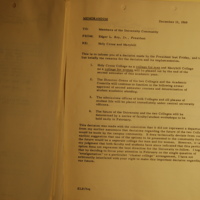How Women Fought: Vocalizing Disparity
![[Women's Opinions on Curfew] [Women's Opinions on Curfew]](http://s3.amazonaws.com/archives-omeka-glen/square_thumbnails/ce0c954df76a74e141e078860f9088a6.jpg)
Maryhill women speak up about their imposed curfew.

Student speaks out against administrative rules.
Vocalizing Disparity
After the election of freshman class officers, the newspaper featured the election of the male officers, but did not cover the election of female students. A Maryhill student submitted a letter to the editor expressing that Maryhill students "protest not because we are the officers neglected, but because we are expected to lead our class in solving its problems and those of the University ... it is the fact that Maryhill is considered little more than that dorm at the bottom of the hill, and not an equally important part of St. Edward's University." [1] From the very beginning, women were determined to counter discrimination.
Although the majority of male attitudes toward the women on campus were belittling, there were men who joined the battle towards female inclusion. In 1966, the newspaper published "Maryhill Women Deserve Respect," an editorial written by St. Edward's student F. Kingston Johnson. Johnson was calling all men to action and legitimizing the presence of women on campus. He states, "to deny the dignity of these women, desecrates the dignity of our university."[2] Written in response to the constant harassment of women in the lunch room and dormitories, he demands that men respect the women.
Maryhill students were also challenged with battling discriminatory administrative policies. In response to the strict rules imposed by university administration, Maryhill student Martha Brown published an article in the newspaper vocalizing her grievances. She criticized the university and its need to “regulate our lives in and outside of class,” and compared her college experience to that of a prison.[3] Three years later in 1972, The Tower (St. Edward’s yearbook) included women’s opinions on the freshmen dorm policies. One student stated that living in freshman dorms was comparable to a babysitting service.[4]
When the idea of a coeducational university became prevalent, many students vocalized their support, or lack thereof, in articles in The Hilltopper. One specific article addressed to St. Edward’s students asked them to become involved in the decision. “It is up to the student bodies of Holy Cross and Maryhill Colleges...to make it known what is best for St. Edward’s University.”[5] When the administration failed to make a timely decision, students realized that the choice between coordinate or co education was also in their hands.
From Incidental to Essential
The second annual elections of Maryhill officers in 1967 received its very own section in the newspaper. Not only are interviews with all four elected officers included, but the article itself was written by a Maryhill student. The elected officers all expressed the importance of taking charge of their education and molding Maryhill into the university they desired it to be. All candidates stressed the importance of taking on leadership positions in the growing stages of Maryhill. Elected officer Rita Carpenter expressed her ultimate goal of uniting St. Edward’s and Maryhill, claiming that there needed to be more contact between men and women on university campuses. It marked the beginning of women acting on their responsibility of fighting for their ultimate goal, which was consolidation.[6]
In December 1969, President Edgar L. Roy announced that Maryhill and St. Edward's would become a coeducational university. This decision was not reached without the persistence of the women who pushed for equal educational and social conditions. Their relentless activism through the platform provided by the newspaper was able to convince the administration that the coordinate system was not helping, but instead hindering the progress of St. Edward's University. Dr. Kathleen Wilburn goes as far as to claim that “Without Maryhill College St. Edward’s University may have disappeared as well.”[7]

